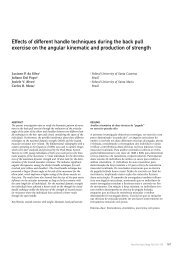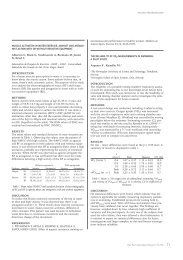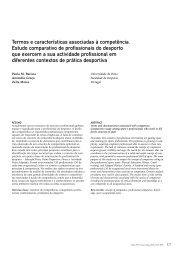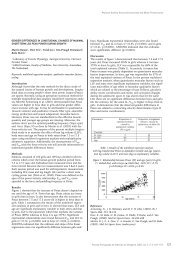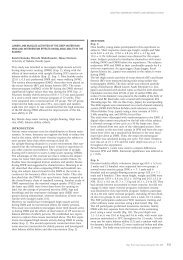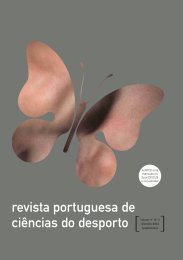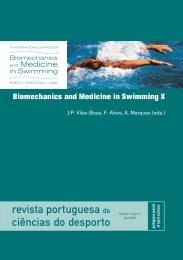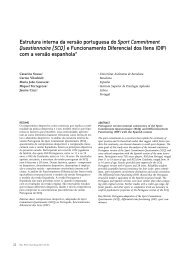35754-Revista FCDEF - Faculdade de Desporto da Universidade do ...
35754-Revista FCDEF - Faculdade de Desporto da Universidade do ...
35754-Revista FCDEF - Faculdade de Desporto da Universidade do ...
You also want an ePaper? Increase the reach of your titles
YUMPU automatically turns print PDFs into web optimized ePapers that Google loves.
ção <strong>da</strong> quali<strong>da</strong><strong>de</strong> <strong>da</strong> coor<strong>de</strong>nação intersegmentar <strong>do</strong>s diferentes<br />
músculos envolvi<strong>do</strong>s, <strong>da</strong><strong>do</strong> que a energia cinética transmiti<strong>da</strong> a<br />
partir <strong>da</strong>s articulações proximais é uma fonte fun<strong>da</strong>mental para<br />
o aumento <strong>da</strong> veloci<strong>da</strong><strong>de</strong> <strong>do</strong> lançamento.<br />
4. Nos lançamentos a optimização <strong>do</strong> ciclo muscular alongamento/encurtamento<br />
é um factor que concorre para aumentar a<br />
potência <strong>de</strong> contracção, nomea<strong>da</strong>mente <strong>do</strong>s músculos responsáveis<br />
pela aceleração <strong>do</strong> braço. É por isso importante no futuro<br />
caracterizar, para ca<strong>da</strong> tipo <strong>de</strong> lançamento, o respectivo ciclo<br />
muscular alongamento/encurtamento nas dimensões duração,<br />
amplitu<strong>de</strong> e veloci<strong>da</strong><strong>de</strong>.<br />
Bibliografia<br />
BUCKLEY, J., & KERWIN, D. (1988). The role of the biceps<br />
and triceps brachii during tennis serving. Ergonomics 31:<br />
1621-1629.<br />
CORCOS, D. et al. (1990). Organizing principles un<strong>de</strong>rlying<br />
skill acquisition. In JM Winters & SL-Y Woo (Eds.) Multiple<br />
Muscle Systems. Biomechanics and movement organization. New<br />
York: Springer-Verlag, 251-267.<br />
COUTINHO, C. et al. (2003). EMG patterns of the upper limb<br />
muscles in the first (flat) and second (topspin) serve of a top<br />
player. In M. Crespo et al. (Eds.) Proceedings of the 13 th<br />
International Training Fe<strong>de</strong>ration Worldwi<strong>de</strong> Coaches Workshop.<br />
Vilamoura, 150.<br />
ELLIOTT, B. et al. (1995). Contribution of upper limb segment<br />
rotations during the power serve in tennis. Journal of Applied<br />
Biomechanics 11: 433-442.<br />
GOWAN, I. et al. (1987). A comparative electromyographic<br />
analysis of the shoul<strong>de</strong>r during pitching. The American Journal<br />
of Sports Medicine 15: 586-590.<br />
ITO, A. et al. (1995). Three dimensional kinematic analysis of<br />
the upper limb joint in tennis flat serving. In K. Hakkinen et<br />
al. (Eds.) Book of Abstracts <strong>do</strong> XVth Congress of the ISBS.<br />
Jyvaskyla: University of Jyvaskyla, 424-425.<br />
MIYASHITA, M. et al. (1980). Muscular activities in the tennis<br />
serve and overhand throwing. Scandinavian Journal of Sports<br />
Sciences 2: 52-58.<br />
PEZARAT-CORREIA, P. et al. (1995a). The triphasic EMG pattern<br />
on elbow ballistic extension during a throwing task. In<br />
K. De Meirler (Ed.) Book of Abstracts of the I Congress of the<br />
European Association of Sports Medicine (EURASM). Bruxelas:<br />
Vrije Universiteit Brussel, 39.<br />
PEZARAT-CORREIA, P. et al. (1995b). The modulation of the<br />
initial agonist activation (AG1) on the elbow extension of a<br />
throwing task performed at different speeds. In K. Hakkinen<br />
et al. (Eds.) Book of Abstracts <strong>do</strong> XVth Congress of the ISBS.<br />
Jyvaskyla: University of Jyvaskyla, 730-731.<br />
PEZARAT-CORREIA, P., et al. (1996). The muscular pattern in<br />
elbow ballistic extension during shot at the goal in the handball.<br />
In P. Marconnet et al. (Eds.) Book of Abstracts of the First<br />
Annual Congress Frontiers in Sport Science. Nice: University of<br />
Sophia-Antilopis, 464-465.<br />
PEZARAT-CORREIA, P. et al. (2001). Differences in the agonist/antagonist<br />
EMG pattern during a throwing task performed<br />
by experimented <strong>da</strong>rt throwers and untrained subjects.<br />
Medicine & Science in Sports Exercise 33, 5 Supplement, S216.<br />
SPRIGINGS, E. et al. (1994). A three-dimensional kinematic<br />
method for <strong>de</strong>termining the effectiveness of arm segment<br />
rotations in producing racquet-head speed. Journal of<br />
Biomechanics 27: 245-254.<br />
RASH, G.; SHAPIRO, R. (1995). A three-dimensional dynamic<br />
analysis of the quarterback’s throwing motion in american<br />
football. Journal of Applied Biomechanics 11: 443-459.<br />
TOYOSHIMA, S., et al. (1974). Contribution of the body parts<br />
to throwing performance. In R. C. Nelson and C. A.<br />
Morehouse (Eds.) Biomechanics IV. Baltimore: University Park<br />
Press, 169-174.<br />
ppezarat@fmh.utl.pt<br />
ESTABILIDADE ARTICULAR E MEDIÇÃO<br />
DA RIGIDEZ DINÂMICA ASSOCIADA.<br />
GRUPOS DE INTERESSE<br />
Abrantes, João M.C.S.<br />
<strong>Facul<strong>da</strong><strong>de</strong></strong> <strong>de</strong> Motrici<strong>da</strong><strong>de</strong> Humana, Universi<strong>da</strong><strong>de</strong> Técnica <strong>de</strong> Lisboa,<br />
Portugal.<br />
Introdução<br />
Des<strong>de</strong> o IV Congresso <strong>de</strong> Ciências <strong>do</strong> <strong>Desporto</strong> e <strong>de</strong> Educação<br />
Física, Coimbra (Gabriel e Abrantes, 1995) temos vin<strong>do</strong> a consi<strong>de</strong>rar<br />
a importância particular que a Estabili<strong>da</strong><strong>de</strong> Articular tem<br />
sobre o conhecimento <strong>do</strong> caminhar, enquanto padrão motor<br />
(Gabriel e Abrantes, 1999; Gabriel e Abrantes, 2001) e qual o<br />
potencial contributo <strong>de</strong> um mo<strong>de</strong>lo <strong>da</strong> rigi<strong>de</strong>z dinâmica para a<br />
tarefa <strong>de</strong> saltitar (hoping), (Fernan<strong>de</strong>s e Abrantes, 2003a). Hoje<br />
procuramos apresentar uma ferramenta que nos possibilite<br />
relacionar a rigi<strong>de</strong>z dinâmica rotacional <strong>do</strong> tornozelo com a<br />
estabili<strong>da</strong><strong>de</strong> articular usan<strong>do</strong> como critério as fases <strong>de</strong> produção<br />
e <strong>de</strong> absorção <strong>de</strong> energia mecânica.<br />
Associação <strong>do</strong> conceito <strong>de</strong> estabili<strong>da</strong><strong>de</strong> articular ao conceito<br />
<strong>de</strong> rigi<strong>de</strong>z dinâmica<br />
Na perspectiva biomecânica o conceito, a<strong>da</strong>pta<strong>do</strong> <strong>da</strong> Mecânica<br />
<strong>do</strong>s Materiais, <strong>de</strong> Rigi<strong>de</strong>z como significante <strong>da</strong> Bioresistência,<br />
<strong>de</strong>senvolvi<strong>da</strong> pelos materiais biológicos presentes, po<strong>de</strong> ser utiliza<strong>do</strong><br />
na construção dum indica<strong>do</strong>r <strong>de</strong> Estabili<strong>da</strong><strong>de</strong> Articular.<br />
Em termos gerais a Estabili<strong>da</strong><strong>de</strong> Articular resulta <strong>da</strong> capaci<strong>da</strong><strong>de</strong><br />
motora <strong>de</strong> controlar os elementos que actuam em ca<strong>da</strong> um <strong>do</strong>s<br />
complexos articulares. O efeito <strong>de</strong> controlo sobre os elementos<br />
activos (ou, neuromusculares) é associa<strong>do</strong> ao efeito <strong>do</strong>s elementos<br />
passivos (proprie<strong>da</strong><strong>de</strong>s mecânicas <strong>do</strong>s materiais que<br />
compõem esses complexos articulares). O resulta<strong>do</strong> <strong>de</strong>sse efeito<br />
associa<strong>do</strong> proporciona ao executante um <strong>de</strong>termina<strong>do</strong> grau<br />
<strong>de</strong> concretização <strong>do</strong> objectivo <strong>de</strong> <strong>de</strong>slocação ou posição intersegmentar.<br />
Essa capaci<strong>da</strong><strong>de</strong> terá graus segurança e soli<strong>de</strong>z que<br />
proporcionam a esse executante uma fiabili<strong>da</strong><strong>de</strong> <strong>da</strong> execução<br />
<strong>de</strong>ntro <strong>de</strong> parâmetros que lhe permitem, por um la<strong>do</strong>, a estabili<strong>da</strong><strong>de</strong><br />
geral <strong>do</strong> corpo e, por outro, uma margem <strong>de</strong> confiança<br />
<strong>de</strong> que o <strong>de</strong>sempenho é mais confortável <strong>do</strong> que realiza<strong>do</strong> em<br />
limites dinâmicos muito próximos <strong>do</strong> <strong>de</strong>senca<strong>de</strong>amento <strong>do</strong>s<br />
processos <strong>de</strong> lesão. Estes limites estão associa<strong>do</strong>s quer ao controlo<br />
sobre os graus <strong>de</strong> liber<strong>da</strong><strong>de</strong> redun<strong>da</strong>ntes, quer aos<br />
momentos <strong>de</strong> força presentes. As variações observa<strong>da</strong>s indicam<br />
a existência <strong>de</strong> uma componente <strong>de</strong> controlo, avalia<strong>da</strong> pela<br />
maior ou menor activi<strong>da</strong><strong>de</strong> muscular <strong>do</strong>s músculos responsáveis<br />
pelos <strong>de</strong>slocamentos intersegmentares, predispon<strong>do</strong> o controlo<br />
a diferentes níveis <strong>de</strong> alerta. Este alerta, ou grau <strong>de</strong> sensibili<strong>da</strong><strong>de</strong><br />
<strong>do</strong> sistema <strong>de</strong> controlo, po<strong>de</strong>rá ser quantifica<strong>do</strong> pelo<br />
maior ou menor grau <strong>de</strong> rigi<strong>de</strong>z necessário à estabili<strong>da</strong><strong>de</strong> exigível<br />
em ca<strong>da</strong> tarefa. Especificamente para o tornozelo, o limiar<br />
<strong>de</strong> sensação proprioceptiva aumenta com a i<strong>da</strong><strong>de</strong> e, portanto, a<br />
<strong>Revista</strong> Portuguesa <strong>de</strong> Ciências <strong>do</strong> <strong>Desporto</strong>, 2004, vol. 4, nº 2 (suplemento) [15–102] 85



